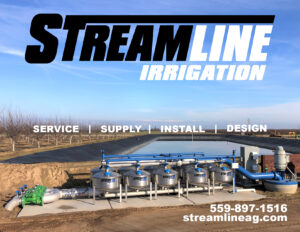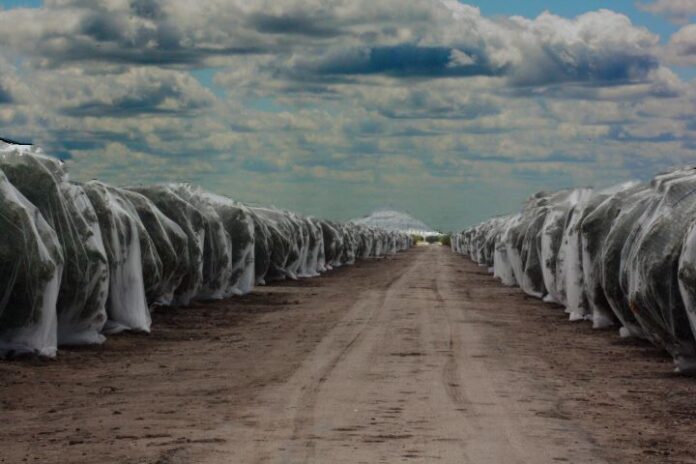The Kaweah Delta Water Conservation District held its board of directors meeting at its Farmersville headquarters and GoToMeetings on Tuesday, February 7, 2023. There must be some construction going on near the headquarters because the lady who really runs things there, Kathleen Halvorsen, had to send out traffic directions on how to get to the offices. I remember that happened once before many years ago with a traffic circle project and I didn’t know my way around as well. I was driving hither and fro trying to find how to get there from a different angle. Stopped and asked one old boy for directions and he just looked at me like he didn’t speak English. Which he didn’t, but he was friendly and helpful and after some rusty Spanglish back and forth I arrived at my destination.
and I didn’t know my way around as well. I was driving hither and fro trying to find how to get there from a different angle. Stopped and asked one old boy for directions and he just looked at me like he didn’t speak English. Which he didn’t, but he was friendly and helpful and after some rusty Spanglish back and forth I arrived at my destination.
There has been some talk about moving the whole shebang to a more rural location. The increased amount of traffic into and out of Farmersville causes not only the need for a new whatever at the intersection of Highway 198 but some hazard when moving equipment as well as high traffic certain times of the day. They had this problem once before and had to move from Visalia to Farmersville.
The Meeting
At 9:06am Chairman Don Mills called the meeting to order. Under public comment Sean Corley GM Lakeside Water Irrigation District stated he wanted to send a big bottle of Crown Royal to a bunch of folks for making it rain.
GM Mark Larsen said the audit is running behind a bit. There is also a tour of the construction on the Friant Kern Canal and he asked those interested to let him know. Water is running down the Friant Kern Canal in the old channel. It’s full upstream from the dam to at least Sanger, if not further.
KDWCD has an old loader that has depreciated to the point of surplus. Mills said he thought it might fetch $10,000 as long as you told the new owner to be sure and park it on a hill. You know, momentum to get it started.
Water Supply
Vic Hernandez, Water Master said it’s been a fun month. Good for him and all the other folks in the industry who have had to give such disappointing reports the past few years. He said flows are coming on the Kaweah River and they may have to jump around with Friant water but there’s so much coming that may not be possible. The Kaweah River watershed is at 129 percent of the April 1st average and it’s not over yet. He said most of the snow is at the 9,000 feet elevation and it’s wet snow with a high water content. He’s waiting for another snow measurement. He said, and engineer Dennis Keller said later in the month one of the biggest atmospheric rivers yet may hit the state. And there are two smaller storms moving in. Mills asked if there was anything in the Airborne Snow Observatory data that was a surprise. Hernandez and Keller said they expected higher numbers but there is a lot of ice mixed in from rain falling and then freezing. That could account for variances.
watershed is at 129 percent of the April 1st average and it’s not over yet. He said most of the snow is at the 9,000 feet elevation and it’s wet snow with a high water content. He’s waiting for another snow measurement. He said, and engineer Dennis Keller said later in the month one of the biggest atmospheric rivers yet may hit the state. And there are two smaller storms moving in. Mills asked if there was anything in the Airborne Snow Observatory data that was a surprise. Hernandez and Keller said they expected higher numbers but there is a lot of ice mixed in from rain falling and then freezing. That could account for variances.
Keller said all the snowpack on the Kings River is between 6,000 to 9,000 feet. The situation on the San Joaquin River is similar. It rained hard all night long in Shaver this past Saturday. But in the morning it started to snow and all the runoff froze. At the same time up the hill in Huntington Lake they got 22 more inches of snow. He also said the ASO flight data lidar is within two or three centimeters from the ground readings in some areas. However, the data without ASO would have under counted the yield by an estimated 300,000 a/f. The consensus is the ASO is an improvement.
District Engineer Larry Dotson reported there is good response on the on-farm recharge program. Good for them.
CVP Report
Larsen said the Section 215 water isn’t starting up right away and Kaweah Delta has about 7,000 a/f of Class II Central Valley Project water. There is now 50 percent Class I allocations and carryover at Millerton Lake will be protected. Keller said Mammoth Pool is full, spilling and continuing to do so. Millerton will be the flood control mechanism for now. After March 1st there will be a new shuffling of the allocation and operations deck with new hands dealt. Actually gambling is not a great analogy, metaphor, simile – can’t recall which is which – there is more certainty to what will happen if the forecasts hold.
Keller said he doesn’t think Shasta will make four million a/f and that will trigger a 75 percent allocation to the Exchange Contractors. He said the heavy storms haven’t been going north of the Feather River and the Sacramento Valley hasn’t been enjoying the wet largesse.
Friant Kern Canal Report
Water Resource Manager for the Friant Water Authority, Ian Buck-Macleod spoke and gave his background with MWH and Stantec Engineering firms working on the San Joaquin River Restoration. He gave the board a report on the history of capacity correction on the FKC. Studies began decades ago but the economics of fixing the subsidence problem didn’t pencil out until relatively recently. The historic 2,700 cfs conveyance will be restored by next year if I understood. The question of restoring the design capacity of 4,000 cfs in the middle reach before other needed repairs and refurbishments along other parts of the canal needs to be answered. So, should Friant contractors continue to spend Phase II money on the FKC?
At the recent Friant board retreat that question was asked and he reviewed the answers. The cost shown for the full canal was between $930 million and $1.9 billion at 2022-dollar values. This includes a good deal of the costs already being spent on current repairs. Phase I is $500 million and that was included.
There were several other options that applied to specific portions of the FKC. Buck-Macleod showed a chart that listed the relative cost benefit ratios of each option and figured in the differing hydrological year types. He said only the upper reach, middle reach or full canal fix penciled out and that wasn’t by much. He said the contractors along the canal were asked to consider local flows. If it’s wet on the San Joaquin River it is usually wet all along the canal. This reduces the FKC supply demand.
Buck-Macleod said the 2014 California Water Commission figures for Prop One were used and he thinks these figures are low and if those were refined and updated the cost/benefit ratio would improve. A chart showing wet year benefits, about 20-percent of the time, were presented as Class I and Class II and both figured together. Kaweah Delta was one district that didn’t fare so well under this scenario. But there is much more refining that needs to be done. Especially for the smaller possible projects. He mentioned Lake Woollumes is a bit small for more than an equalization pond but there are opportunities for a Friant-wide100,000-500,000 a/f water bank. It won’t be cheap and FWA isn’t looking at a family plan. They are maybe 10 Class II contractors who would best benefit from this. The purpose is to provide a place to park extra flows during wet years when the contractors can’t take them. If I heard right it will take almost $200,000 to start the study and maybe some unused Temperance Flat funds could be shifted or some US Bureau of Reclamation aging infrastructure funds could be used to get this up and running. He said a finalized study is looking at $17 million to complete.
Larsen said all the districts provided their data to this effort and it was difficult for Kaweah Delta to figure in local flood releases. Mills asked if the benefits to contractors’ analysis included the local projects and Buck-Macleod said only the existing local projects or those currently in the pipeline were included. Larsen said the Hannah Ranch project was included in KDWCD’s estimate but could be refined.
Director Chris Tantau said from what he’s seen the cost are pretty high. He asked if a cost per acre foot was determined. Buck-Macleod said that hasn’t been done yet. Tantau said he did it on the back of a napkin then threw the napkin away. Buck-Macleod said the cost/benefit ratio wasn’t exactly compelling but further study could improve things.
Geoff Vanden Heuvel asked if this further groundwater banking were to take place could that water be available to white areas. Buck-Macleod said this is possible with the right mix of sales and transfers. Vanden Heuvel said he expects the white areas would be willing to invest.
Keller said there is some endangered plant at Hungry Hollow, the spiny sycamore or some such that would negate using that part of the world for large scale recharge. He said Provost & Pritchard, Dr. Ken Schmidt and himself have been looking at some property owned by Lindsay Strathmore ID for a location to bank such a big area. Mills said there is a lot of recharge capacity at McCabe point but the groundwater level is already high and moving 20,000 a/f up and down could be a challenge.
Keller advised the board to get their 215 contracts together. He referred to the way Tulare Irrigation District operates its balancing act between FKC and Kaweah River deliveries as a good example of how to do it. He said grabbing three wet years out of 10 pencils out but one out of 10 is pretty tough. He said the USBR “screwed up” the Class I costs and ran them up to a point recharge incentives were removed.
Hannah Ranch Report
Staff gave a report on the Hannah Ranch project. There will be a need for more riprap to prevent erosion.
SGMA
Larsen reported the Mid Kaweah Groundwater Sustainability Agency sent out its invoices but Greater Kaweah GSA is still working on them. There has been progress on the land fallowing program. There will be public events coming up. GKGSA applied for the Land Flex program and that is very limited. They’ll find out later this month which Groundwater Sustainability Plans were accepted. DWR is looking to release its evaluations on the GSPs in the first quarter of this year. It’s either pass or fail and those that fail are referred to the State Board. Larsen said he’s possibly looking to Land IQ for more help in collecting data before invoicing.
Sustainability Plans were accepted. DWR is looking to release its evaluations on the GSPs in the first quarter of this year. It’s either pass or fail and those that fail are referred to the State Board. Larsen said he’s possibly looking to Land IQ for more help in collecting data before invoicing.
Kaweah Water Foundation
Sarah Rutherford of the Kaweah Water Foundation said she didn’t have much bad news to report. She said Tulare County got $200,000 for more drinking water kiosks. Tulare County has fire stations, libraries and other county owned properties and these locations make the most sense for new kiosks. Rutherford was also appointed for a two-year term on a state wide committee dealing with CV Salts. Kaweah Delta is applying for a grant that will be administered by the KWF. There is help available from Perry Claussen’s group (Irrigation Lands?) to help prevent reinventing the wheel. She said KWF is short staffed and the workload is gaining beyond what was expected. Rutherford said she’s been working with Claussen for a long time and it’s been a good working relationship. She used to work for Provost & Pritchard before taking over the Kaweah Water Foundation. Rutherford’s efforts have been a success story by all accounts.
(Irrigation Lands?) to help prevent reinventing the wheel. She said KWF is short staffed and the workload is gaining beyond what was expected. Rutherford said she’s been working with Claussen for a long time and it’s been a good working relationship. She used to work for Provost & Pritchard before taking over the Kaweah Water Foundation. Rutherford’s efforts have been a success story by all accounts.
Closed Session
Mills announced March 7th 9:00am as the next meeting date. Things went into closed session for two potential cases of litigation and two personnel matters at 10:38am. That as that. Go be good to yourself and others.
DISCLAIMER OF RESPONSIBILITY; Waterwrights.net strives to provide readers and clients with the most complete, up-to-date, and accurate information available. Nevertheless, Waterwrights.net does not serve as a guarantor of the accuracy or completeness of the information provided, and specifically disclaims any and all responsibility for information that is not accurate, up-to-date, or complete. Waterwrights.net’s clients therefore rely on the accuracy, completeness and timeliness of information from Waterwrights.net entirely at their own risk. The opinions expressed in this report are those of the author and do not represent any advertisers or third parties.
ALL RIGHTS RESERVED. Copyright 2023 by www.WaterWrights.net/DAW
Kaweah Delta Water Conservation District
2975 N. Farmersville Blvd.
Farmersville, California 93223
559/747-5601
KDWCD is part or the Greater Kaweah GSA DWR #5-022.11
Board of Directors
Don Mills – President, Chris Tantau – Vice-President, Ron Clark, Jimi Valov, Jeff Ritchie, Eric Shannon & Brian Watte
Management
Mark Larsen, General Manager – mlarsen@kdwcd.com
Terry Stafford, Facilities Manager – tstafford@kdwcd.com
Debbie Vierra, Administrative/HR Coordinator – dvierra@kdwcd.com
Larry Dotson, Senior Engineer – ldotson@kdwcd.com
Shane Smith, Projects/Administrative Manager – ssmith@kdwcd.com
Office and Field Staff
Water Master – Victor Hernandez, Office Assistant – Kathleen Halvorsen
Primary ConsultantsDennis Keller – Civil Engineer (Keller/Wegley Consulting Engineers), Aubrey Mauritson – Attorney (Ruddell, Cochran, Stanton, Smith & Bixler, LLP)
From the Kaweah Delta website:
The Kaweah Delta Water Conservation District (KDWCD) was formed in 1927, under the provisions of California state law known as the Water Conservation Act of 1927, for the purpose of conserving and storing waters of the Kaweah River and for conserving and protecting the underground waters of the Kaweah Delta. Later the Water Conservation Act, as well as the purpose of the District, was expanded to include power generation and distribution.
The District is located in the south-central portion of the San Joaquin Valley and lies in portions of both Tulare and Kings Counties. The total area of the District is about 340,000 acres with approximately 255,000 acres located in the western portion of Tulare County and the balance, or 85,000 acres, in the northeastern portion of the Kings County.
The Districts lands are primarily agricultural in nature, although the cities of Visalia and Tulare constitute significant areas of urbanization. Farmersville is the other incorporated area. The population of the District is currently estimated to be in excess of 175,000 people with the principle crops being cotton, misc. field crops, deciduous fruit and nut trees as well as alfalfa.
Numerous public and private entities within the District’s boundaries divert water from the Kaweah River and its distributaries. Nearly all of the lands served with Kaweah River water also are served irrigation water from groundwater, primarily due to the erratic and relatively undependable nature of flow on the Kaweah River. All municipal and industrial water uses within the District are supplied from groundwater.
KDWCD and Tulare Irrigation District (TID), which lies entirely within the boundaries of the Kaweah Delta Water Conservation District, has a long-term contract with the federal Central Valley Project (CVP) for water from the Friant Division of the CVP. TID has historically received substantial quantities of CVP water surplus to the demands of the District which augment the Kaweah River supply.
The District and the Kaweah River groundwater basin have experienced long-term groundwater overdraft estimated in 2007 to be as much as 40,000 acre-feet per year. The District has performed multiple studies of groundwater data to determine the extent and volume of groundwater overdraft within its boundaries. There are currently over 40 recharge basins within the District covering approximately 5,000 acres. While KDWCD owns and operates many of these groundwater recharge basins, it does not provide water banking services for others.

































